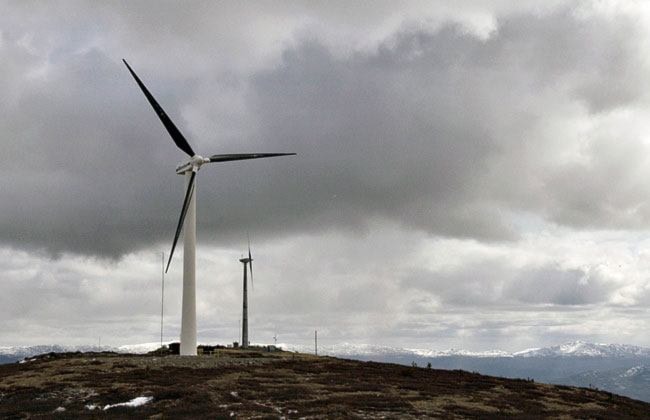David Morrison has changed direction on wind.
Just over a year ago, the president of Yukon Energy was contemptuous of wind power in the territory.
“In very efficient wind projects - which the Yukon couldn’t have, but let’s say that it could - the wind turbines would operate 30 per cent of the time,” said Morrison in a past interview with the News.
“What do I do when the wind doesn’t blow?” he said.
“We’re not saying all wind is bad, we’re saying, in this instance, it’s not the right alternative because we’re going to have to supplement it with diesel.
“That’s when the economics of wind power get blown right out of the water.”
Now, 16 months later, Yukon Energy is planning to build a wind farm on Ferry Hill, near Stewart Crossing.
“Projects like wind are looking better today,” said Morrison, responding to his previous comments.
“And it’s not personal biases that count,” he added.
Morrison’s about-face may have something to do with Yukon Energy’s power crisis.
The utility is fast running out of energy.
Within five years, it will need to come up with roughly 200 more gigawatt hours of power. (Currently, the grid is only capable of supplying the territory with 375 gigawatt hours.)
But in a power crunch, wind seems like a strange choice.
Wind farms are only feasible if there’s surplus hydro to toss around when the wind doesn’t blow, Morrison told the News in 2009.
Today, surplus hydro is even scarcer than it was then, with the utility burning more than 600,000 litres of diesel on the Mayo/Dawson grid in 2010
- up from 138,000 litres in 2009.
That’s a 340 per cent increase.
Even though there is no surplus power to toss around, wind is suddenly a viable option, said Morrison.
Haeckel Hill has problems, he said.
But Ferry Hill and Mount Sumanik, which have been undergoing wind studies for the past five years, look more promising, he said.
They didn’t in 2009.
“Those wind studies (at Ferry Hill and Mount Sumanik), which involved wind measurements across the Yukon, were never very useful,” said Morrison at the time.
Today, that has changed, he said.
“The data wasn’t looking good at all,” said Morrison on Wednesday.
“But we persisted.
“And if the data’s saying something negative, then it’s negative and if it’s saying something positive, then let’s look at it.”
The wind studies should only have taken three years, said Morrison.
But Yukon Energy had trouble with the wind monitors.
“So it went on longer than we thought,” he said.
This month, a taller monitor is being set up on Ferry Hill ” to really confirm the data.”
If it jives with past numbers, Yukon Energy could be ordering wind turbines by the end of this year, said Morrison.
“I’m no expert, but I’m guessing there will be about 15 windmills, maybe a few more,” on Ferry Hill, he said.
When the wind is blowing, these turbines will supply 20 megawatts of power, or maybe a little bit less, said Morrison.
The project will cost $70 to $80 million “or maybe a little bit more,” he added.
To pay for it, Yukon Energy might “find some contribution,” he said.
“Or, if the economics are there, it will go into rates.
“That’s how we fund what we do; we’ll have to borrow the money, but over time ratepayers would pay for it.”
Morrison isn’t sure how much wind will cost, per kilowatt hour.
“Those are the kinds of numbers I don’t have yet,” he said.
“That’s the kind of stuff we’re still looking at.”
But to make it economically viable, it has to be cheaper than diesel.
Diesel costs 30 cents a kilowatt hour.
“So if it’s renewable and cheaper than diesel, then over time whatever the cost is goes down, like hydro,” he said.
To be viable, Ferry Hill also needs to have its turbines spinning 30 per cent of the time.
At half that, Haeckel Hill didn’t even come close.
“We don’t get a lot of great efficiency out of Haeckel for a number of reasons,” said Morrison, mentioning icing issues.
“But we think with Ferry Hill, we’re going to get 30, and based on that, we’d get an output of 20 megawatts.
“So it should be economical.”
When the wind is blowing, the utility hopes it can use Ferry Hill’s 20 megawatts to replace water flowing over the dams at Aishihik and Mayo.
“If the wind is blowing and the turbines are being used to create energy, then we may not have to run all of the hydro as much as we would normally, therefore storing some water,” said Morrison.
But with a projected 50 per cent spike in power demand, being able to shut off hydro when the wind is blowing may not be an option.
And using diesel to supplement wind - something Morrison said would “blow the economics of wind right out of the water” back in 2009 - may now be the only option.
There may be times in winter when the wind doesn’t blow and we’d need to get more out of the system, said Morrison.
And diesel would be an option, he said.
But Yukon Energy is also hoping Yukoners cut down their power usage, he said.
And the utility is considering water storage projects, like Atlin Lake, and looking at burning garbage to make energy.
“Because unless the load curve changes dramatically, we’re going to have to do more than just wind,” said Morrison.
Contact Genesee Keevil at
gkeevil@yukon-news.com
